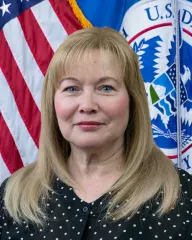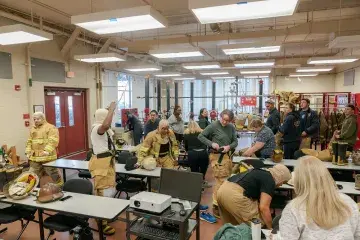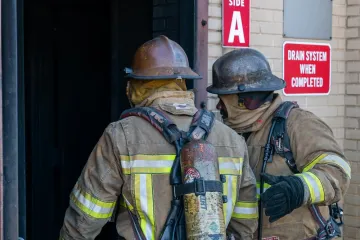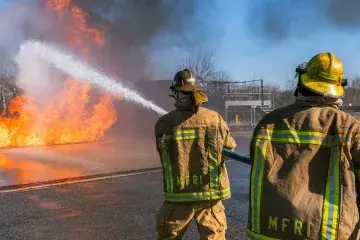Guest post from Wendy Howe, Director of the Science and Technology Directorate’s (S&T) Communications and Outreach Division (COD).

Members of S&T’s communications team recently spent a brisk morning at the Maryland Fire and Rescue Institute (MFRI), but we did not feel cold for very long on that chilly day—we started off with a warm welcome by the MFRI administration and instructors and before we knew it, we were dressed in firefighting turnout gear and in a small room facing a real fire in a training scenario.
I am not exaggerating when I tell you that MFRI is one of the premier fire training facilities in the United States. It is responsible for training all the firefighters in the state of Maryland that work in jurisdictions that do not have a dedicated fire training academy. They also train a large percentage of the military’s firefighting personnel, and travel around the world to assist first responders in other countries with training and ongoing education. On this particular day in early December, these dedicated career responders offered our team a taste of what they and countless others experience every day when lives are on the line.
S&T has a very close and long-standing relationship with first responders and has, from its very inception, designed and created technology solutions to make their jobs easier and safer. We work with and for them, helping to define what their pressing needs are and what new protective gear or communications equipment or mobile app will be able to address them. We are especially proud of all the research and development efforts S&T has undertaken to directly support firefighters. You can check out some of these innovations for yourself at our Equipping Our Everyday Heroes exhibit.

COD’s mission is to share word about how S&T is helping to bring solutions not just to the drawing board, but to the marketplace and ultimately to those on the front lines who need them to keep us safe. We accomplish this through blogs, articles, photos, videos, and now podcasts, so our audiences can stay up to date on the great work coming out of S&T. In my opinion, the best way for us to continue to really tell these in-depth stories is for us to put ourselves in responders’ shoes…or better yet, in their boots. So, that is what we did—we got hands-on with their turnout ensembles and equipment and were immersed in the types of situations firefighters face. MFRI was the perfect place to get that kind of experience. Below is a brief recap of our day as honorary firefighters.

COD staff first suited up in heavy-duty, fire-resistant pants, jackets, boots, gloves, and helmets. The firefighting gear was essential to protect our team while they were running through training exercises. Each person was given a Self-Contained Breathing Apparatus (SCBA), which consisted of an air tank with a harness and a full-face mask. Each harness also held a motion sensor that would trigger an alarm if the wearer stopped moving. This sensor alerts firefighters in darkened smoke-filled structures that a fellow firefighter is motionless and may be incapacitated and helps them locate their colleague by following the piercing sound. We were taught to continually rock and sway our hips to keep the alarms silent.

After the instructors checked the fit and function of each SCBA, they led the team into a small room, shut the door, and proceeded to set a wooden pallet covered with wood shavings ablaze. The vital importance of the technology and equipment that S&T helps to deliver was made abundantly clear as the temperature rose to 1,000 degrees and the room filled with smoke. The equipment we were wearing was quite literally keeping us alive. The heavy turnout gear kept the heat at bay, and the SCBA provided air to breathe and shielded our lungs from smoke.
We also deployed hoses, learned about the work done by emergency medical technicians and the equipment they rely on, and navigated our way on hands and knees in complete darkness through obstacle courses filled with the kinds of debris found in a building on fire.
This was the second time our COD team was put through the paces at MFRI, and we came away with an incredible appreciation for the challenges firefighters face each day in the line of duty.
Thank you to the fantastic group of dedicated professionals at MFRI for giving us a peek into your world. I am honored that S&T has the opportunity to work with first responders every day to develop solutions that protect them as they fight to protect us. We can’t wait to do it again!
